Dual CPU Database Server Comparison
by Johan De Gelas on December 2, 2004 12:11 AM EST- Posted in
- IT Computing
Benchmark Configuration
To ensure that our databases work stably and reliably, we followed the guidelines of SUSE and IBM. For example, DB2 is only certified to run on the SLES versions of SUSE Linux; you cannot run it on any Linux distribution. We also used the MySQL version (3.23.52) that came with the SUSE SLES8 CD's, which was certified to work on our OS.Software
IBM DB2 Enterprise Server Edition 8.1.3 (DB2ESE), 32 bit and 64 bitMySQL 3.23.52, 32 bit and 64 bit
SUSE SLES 8 (SUSE Entreprise Edition) SP3, Linux kernel 2.4.21, 32 bit and 64 bit
Hardware
We'll discuss the different tested servers in more detail below. Here is the list of the different configurations:Intel Server 1: Dual Intel Nocona 3.6 GHz 1 MB L2-cache, 800 MHz FSB - Lindenhurst Chipset
Intel® Server Board SE7520AF2
2 GB (4x512 MB) Micron Registered DDR-II PC2-3200R, 400 MHz CAS 3, ECC enabled
NIC: Dual Intel® PRO/1000 Server NIC (Intel® 82546GB controller)
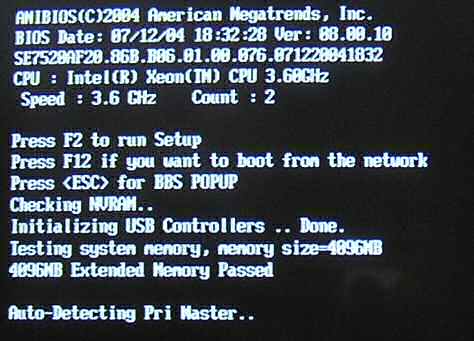
Intel Server 2: Dual Xeon DP 3.06 GHz 1 MB L3-cache, Dual Xeon 3.2 GHz 2MB L3-cache, Dual Xeon 3.2 GHz
Intel SE7505VB2 board - Dual DDR266
2 GB (4x512 MB) Crucial PC2100R - 250033R, 266 MHz CAS 2.5 (2.5-3-3-6)
NIC: 1 Gb Intel RC82540EM - Intel E1000 driver.
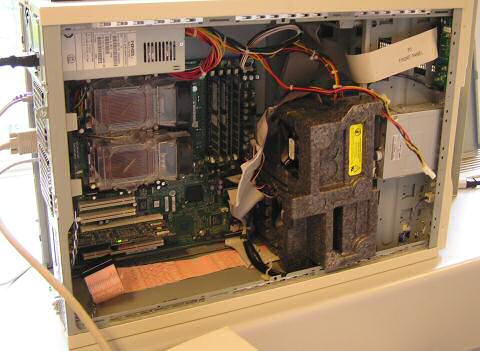
Opteron Server 1: SUN V20z Dual AMD Opteron 248 (2.2 GHz)
Newisys Khepri based board
2 GB: 4x512 MB Infineon PC2700R - 250033R (2.5-3-3-6)
OR 2 GB: 4x512 MB Mushkin PC3200R-232 (2-3-2-6)
NIC: Broadcom 5703, bcm5700 driver
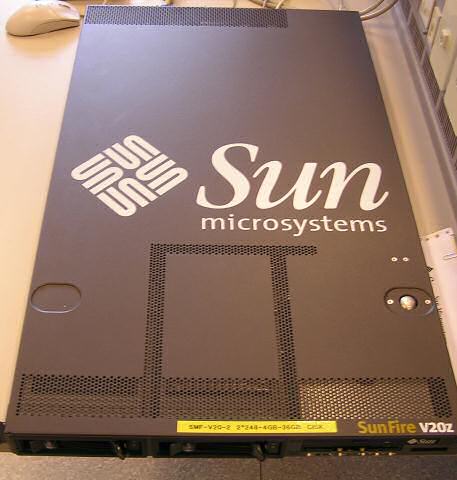
Opteron Server 2: HP DL-145
HP motherboard
2 GB: 4x512 MB Infineon PC2700R - 250033R (2.5-3-3-6)
or 2 GB: 4x512 MB Mushkin PC3200R-232 (2-3-2-6)
NIC: Broadcom 5703, bcm5700 driver
Opteron Server 3: Tyan Thunder K8W (S2885) based
Tyan K8W S2885
2 GB: 4x512 MB Infineon PC2700R - 250033R (2.5-3-3-6)
or 2 GB: 4x 12 MB Mushkin PC3200R-232 (2-3-2-6)
NIC: Broadcom 5703, bcm5700 driver
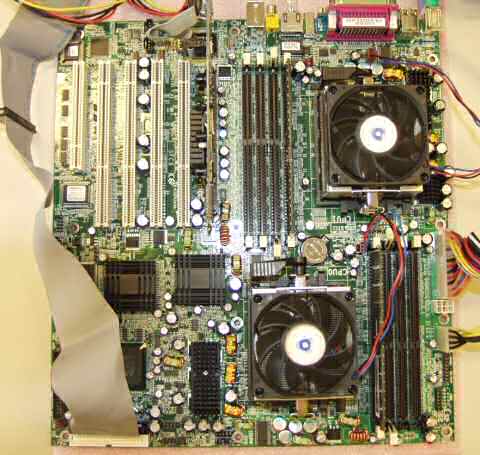
Opteron Server 4: HP DL-585
HP custom designed motherboard
4 GB: 8x512 MB Infineon PC2700R - 250033R (2.5-3-3-6)
NIC: Broadcom 5703, bcm5700 driver
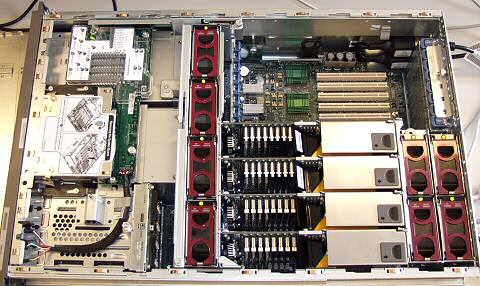
Opteron Server 5: AMD Quartet: Dual 844, Dual 848, Quad 844 and Quad 848
Quartet motherboard, Zildjian personality board, Tobias backplane board and Rivera power distribution board.
Quad configurations: 4 GB: 8x512 MB infineon PC2700 Registered, ECC enabled
Dual configurations: 2 GB: 4x512 MB infineon PC2700 Registered, ECC enabled
NIC: Broadcom NetExtreme Gigabit
Client Configuration 1: 1x Pentium 4 3.06 GHz HT on - 533 MHz FSB
MSI GNB MAX FISR (E7205)
2x512 MB Crucial PC2100R - 250033R (2-2-2-6)
NIC: 1 GB Intel RC82546EB - Intel E1000 driver
Shared Components
1 Seagate Cheetah 36 GB - 15000 rpm - 320 MB/s
Maxtor 120 GB DiamondMax Plus 9 (7200 RPM, ATA-100/133, 8 MB cache)










46 Comments
View All Comments
JohanAnandtech - Thursday, December 2, 2004 - link
About SLES9 and NUMA: NUMA is also supported by Linux kernel 2.4.21 and it boosts performance only a tiny bit. The reason are the very speedy HT links which keep latency at a minimum.It is still possible that kernel 2.6 NUMA support is far better of course, but I doubt it makes a difference for quad or dual systems as there is only hop in quad systems. With two hops (8 CPUs) from CPU 1 to 8 for example, this will become important.
AtaStrumf - Thursday, December 2, 2004 - link
A TYPO:So for now, the Opteron has an advantage still, but it ***can*** /can't/ knock out the Xeon, as it could have a few months ago, before the Xeon Nocona arrived.
HardwareD00d - Thursday, December 2, 2004 - link
There have been enough benchmarks on the web for a long time which show that Opteron generally wipes Xeon's a$$ hands down, and scales far better in multi processor configurations. The latest Xeon is nothing special compared to prior versions and will no doubt preform better mostly due to its increased clock speed. Xeon will never be better than Opteron no matter how much cache and tweaks Intel adds.Maybe Intel's next server architecture will be something to woo, but that's a ways off.
jshaped - Thursday, December 2, 2004 - link
as a long-time reader of aceshardware, i'll be the first to welcome Johan here, great first article. keep them coming!!!!HardwareD00d - Thursday, December 2, 2004 - link
I don't think there are enough variations of the way requests are handled to make a realistic conclusion for either chip. I'm sure you could create a situation where Intel bests AMD in My Sql, and vice versa. This article really needs more benchmarks and more in-depth analysis. Still, it provides enough information to conclude that both Xeon and Opteron have their strengths and weaknesses.mczak - Thursday, December 2, 2004 - link
Nice read. I really think though you should have used SLES 9. Not only does it use kernel 2.6, but it's also NUMA-aware (and DB2 should specifically support it, though it might not have been released yet). SLES 9 also ought to be faster especially on x86_64 due to newer compiler (not that it would matter much with precompiled databases, but every bit counts...). Though for 2-cpu boxes, NUMA might not be that important - but it's safe to predict a landslide victory for a 4-cpu opteron with NUMA support vs. a 4-cpu xeon box. Xeons simply don't scale to 4 cpus, intel might sell them but they are useless (especially since the Xeon MPs are still limited to 400 (or was that 533?) Mhz FSB.A pity though the quad opterons don't support ddr-400. I guess manufacturers decided it's more important to have a boatload of ram slots than fewer slots (with shorter traces) with higher speeds...
And btw, where are the 90nm Opterons? AMD's latest roadmap shows them as available in 2004, which doesn't leave too much time...
bthomas - Thursday, December 2, 2004 - link
Bogus conclusions about IBM tests IMO. From the
article:
> If we had published a similar report back in
> August, the Opteron would enjoyed a landslide
> victory. Luckily for Intel, Nocona is very
> competitive and is about 5% faster than the Opteron 250.
and later in the "conclusion":
> Nevertheless, AMD cannot sit on its laurels.
> Intel made a very good comeback with Nocona, as > this 3.6 GHz CPU is just a tiny bit faster in >
DB2.
It has not.
You fail to specify that this is comparing the _32 bit_ mode for the Opteron. IF you compare the Nocoma performance to the Opteron 64 bit capability...it sweeps the the Nocona in all tests.
The true conclusion is that based on the results in the article, for neither of the databases tested do *any* of the Intel processors compete with the Opteron.
fitten - Thursday, December 2, 2004 - link
Randomized benchmarks are hard to verify as well. You could get a "good" distribution that really takes advantage of cache locality while another randomization may be very cache unfriendly. I agree with #5 to a degree. A database that fits entirely inside of RAM isn't very interesting, ultimately.Still, I am happy that AnandTech is going down these paths of benchmarking instead of just being about Doom3, HL2, and FarCry like most other sites. I eagerly await further database benchmark articles.
PrinceXizor - Thursday, December 2, 2004 - link
#5 - Since when do top tier e-commerce cites compare to mid-level company database users as the beginning of the article mentioned?My company is an engineering firm that does custom electronics. Our database server handles all the transactions for our Inventory/MRP system which is mostly reads. These benchmarks are very appropriate. I wish I could have convinced my boss to go Opteron. Its funny, they had Athlon MP's before and then switched to Xeons when Opteron was out. Go figure.
Anyway, great article. I'm not IT guy by any stretch, but I enjoyed the article.
P-X
Jason Clark - Thursday, December 2, 2004 - link
#6, done ages ago..http://www.anandtech.com/IT/showdoc.aspx?i=2205
http://www.anandtech.com/IT/showdoc.aspx?i=1982